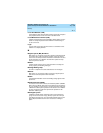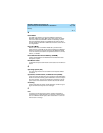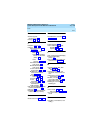
DEFINITY AUDIX System Release 4.0
System Description Pocket Reference
585-300-214
Issue 1
May 1999
Glossary
GL-9
N
Native Mode
The ability of the switch to recognize the DEFINITY AUDIX as a
DEFINITY AUDIX circuit pack. With native mode support, the switch
reserves five slots for the DEFINITY AUDIX 3.2 assembly, and two
slots for the DEFINITY AUDIX 4.0. Additionally the switch is able to
correctly identify the DEFINITY AUDIX board in alarms sent to the ser-
vices organization.
Non-native Mode
Without native mode, the MFB or TN568 slot is provisioned as a
TN754, TN2181 or TN746B, the five slots occupied by the DEFINITY
AUDIX 3.2 assembly or two slots occupied by the DEFINITY AUDIX
4.0 are not reserved, and alarms are reported as alarms for a TN754,
TN2181, or TN746B.
Nonvolatile Random Access Memory (NVRAM)
A battery-backed RAM on the Multifunction board that retains data
through loss of power.
Null Modem Cable
A cable that transposes transmit and receive leads on an RS-232 con-
nection.
O
Operating System (OS)
The set of programs that runs the hardware and interprets software
commands.
Operations, Administration, and Maintenance (OA&M)
A state of system operation where core processes of the Multifunction
board are accessed, including system initialization, resource configura-
tion, forms interface, entry into the maintenance subsystem, and file-
system access. Also entered when customer data must be restored.
Outcalling
A feature that allows the system to dial subscribers’ numbers or go to
pagers to inform them they have new messages.
P
Port
A connection or link between two devices, allowing information to
travel through it to a desired location. For example, a switch port con-
nects to a DEFINITY AUDIX port to allow a subscriber on a voice ter-
minal to leave a message.


















